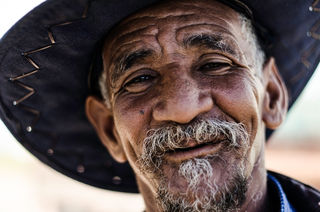Aging
Standing Up to Ageism
Looking for a Mighty New Year's Resolution? Try Embracing Age.
Posted December 29, 2016
Once upon a time, I served on the conservation commission in a town where I lived.

And every so often, the members of the various commissions and boards would get together to shoot the breeze at a local restaurant. Prior to one of these gatherings, I was particularly excited to meet a former member of the commission who I knew would be attending. In the commission’s entire history, he was the longest serving member. He was also a legend with a reputation for being a real character—bold, outspoken, informal, willing to take chances and utter controversial statements, and deeply passionate about conservation. I couldn’t wait to meet this revered figure in the flesh and pick his brain about the history of the commission, his work on it, and his vision of the town’s future. Yet, when I met him I realized that he did not reflect the man people chronicled. He was soft-spoken and, although he was extremely polite and pleasant, it felt like the proverbial tooth-pulling to get anything out of him. He then made it clear why, stating, “Old people should be seen, not heard.” What?! Astonishment and sadness filled me. This man was once a lively, opinionated tiger who used his voice for a great cause. What happened?
What happened is ageism. It encompasses a jumble of biased ideas and practices related to a person’s age. The especially slippery part about ageism is that we can witness it in action time and again throughout society, often without anything triggering our internal antennae that tells us “Hey, something is deeply amiss here.” It’s sort of like a plant that seems harmless on the surface while legions of thorns sprout underneath, piercing skin once you grab hold. The sorts of thorns we’re talking about include:
- Unflattering stereotypes about a person’s age (e.g., unattractive, less capable, “uncool”)
- Agreeable yet nonetheless paternalistic stereotypes (e.g., unassuming, sweet)
- Views about how people should behave based on their age (e.g., don’t speak out, hide your sexuality, don’t wear that, don’t go there, get out of the way of younger people)
- Discrimination toward people solely based on their age (e.g., hiring and promotion decisions)
Unfortunately, the prejudice and discrimination of ageism remains hidden, by and large, flying under the proverbial radar even though it’s culturally pervasive. But why? In all likelihood, because many of us smoothly accept ageist beliefs as clear-cut reality. It’s not hard to find good-hearted people who passionately denounce bigotry in its many forms, yet breezily utter blatantly ageist comments. Undoubtedly, this does not come from a place of malice in most cases. We can’t see bias when we think we’re describing a fact of life. For instance, I don’t think I’m voicing colorist speech when I say the sky is blue; that’s just the way things are, right?
What’s even more disquieting than ageism itself is its impact. Science tells us that ageist attitudes can have a profoundly harmful impact on older adults’ employment, their economic and social opportunities, and their mental and physical well-being. People who are older face ageist attitudes in the very system they entrust their healthcare to (including many physicians and psychologists), which ends up reducing the quality of care they receive. Problems that erode quality of life are apt to receive less active inquiry, attention, and treatment from healthcare providers. For instance, if you’re an older adult with a brain injury, providers are more likely to fail to notice your needs for services compared to a younger person with a brain injury. What if you’re an older woman who is experiencing abuse at the hands of your intimate partner? Sadly, social workers are less prone to look on what’s happening to you as abuse compared to a younger woman in an abusive relationship. Even many of the textbooks used to educate and train the geriatric healthcare providers of tomorrow are rife with ageism. One study analyzed the language in textbooks written for physicians and professionals specializing in geriatrics. It revealed that over half (55%) of the geriatrics textbooks painted a broadly unfavorable portrait of older adults’ cognitive abilities, and roughly one third (32.5%) depicted a somewhat adverse image of the intellectual abilities of older people. Only 12.5% of the books offered a truly evenhanded view of cognition and growing older. And if you’re doing the math, you’ll realize that no books illustrated an optimistic take on aging. When the very tools we use to train healthcare professionals reflect ageism, it’s hardly staggering that we’re churning out providers who hold ageist views themselves.
There’s also a medley of damaging, ageist biases in daily life. True, people tend to envision older individuals as warmer than younger folks, but this doesn’t mean that the overall picture is an approving one. The big picture is one that portrays older adults as less capable people to feel sorry for. Interviewers will give an older job applicant lower ratings even though their qualifications are comparable to a younger applicant.
Regrettably, many older individuals also come to take on ageist stereotypes themselves, moving through life in lockstep with those biases, elevating the odds they’ll actually come true. If you doubt this, take a moment and consider what limitations you place on yourself because of age. Have you ever thought that you were too old to do something that younger adults do and then stopped doing it purely because you accepted this belief?
We used to love going out dancing at nightclubs together, but we can’t do it anymore. We’re just too old to go—we’d look ridiculous…Ah, to be young again…
It’s a self-fulfilling prophecy.
What about the flip side? Have you ever found yourself telling someone that he or she was too old for something? If so, I bet you were coming from a well-intentioned, concerned place.
You can’t take up surfing, grandpa! You’re too old!
But if grandpa listened, that would be another self-fulfilling prophecy. When we unquestioningly accept and follow ideas about what behavior is kosher for old people, then we become the old people we envision. Not only does this confirm our own ageist beliefs, it fuels others’ age biases too when they see us acting out the stereotype.
Ageist notions can even lead young people to move more sluggishly, in line with a common stereotype. People who anticipate that aging means feeling down and being infirm and absent-minded are more likely to have such problems as they age. And unfavorable expectations about aging are more common than you might think. For example, no one says a word when younger people have an absent-minded or forgetful moment, but toss a batch of years into the mix and now it’s a senior moment, considered part and parcel of aging. Personally, I’ve been having senior moments since I was a child! As the American Psychological Association observed, “For the human brain, there’s no such thing as over the hill.” This isn’t to say that brains don’t change at all with time, but our dismal stereotypes about memory loss and aging do not map onto reality for most folks. So the next time I forget, I think I’m going to call it a human moment.
Indeed, bleak predictions on aging can set us up for a gloomier reality over time. If we harbor cynical attitudes about the ticking of the clock, then feeling older saps the enjoyment we get out of life and how healthy we feel. And ageist beliefs about sex (e.g., older people aren’t sexual) are linked to a dimmer sex life. Ladies and gentlemen, if you never had a reason to vigorously tackle ageist notions, you have one now!
Happily, we don’t have to hold onto our stereotypes about aging, and we don’t have to make them come true. Actually, research suggests that we have a lot to look forward to as we hold hands with Father Time. Despite societal ageism, our overall emotional health tends to rise as we get older. We evolve and become more sophisticated artists of living over the years.
Ageist norms about what we’re supposed to be doing (or not doing), or what we’re supposed to be like or look like are woven throughout our culture. Thankfully, we have the choice to bring ourselves back to the big picture of life, reminding ourselves that the experience of growing old is a gift not all of us receive. And for those of us who get it, what better way to take advantage of precious added time than by enjoying a healthy, connected, meaningful, and fun life on our own terms, rather than buying into ageist stereotypes and weighing ourselves down with them?
My thoughts sometimes turn to the conservation legend I met that night. I hope he’s happy and creating more space to be his outspoken self. I know he’s in there somewhere.




